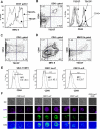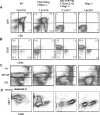TSCOT+ thymic epithelial cell-mediated sensitive CD4 tolerance by direct presentation
- PMID: 18684012
- PMCID: PMC2494558
- DOI: 10.1371/journal.pbio.0060191
TSCOT+ thymic epithelial cell-mediated sensitive CD4 tolerance by direct presentation
Abstract
Although much effort has been directed at dissecting the mechanisms of central tolerance, the role of thymic stromal cells remains elusive. In order to further characterize this event, we developed a mouse model restricting LacZ to thymic stromal cotransporter (TSCOT)-expressing thymic stromal cells (TDLacZ). The thymus of this mouse contains approximately 4,300 TSCOT+ cells, each expressing several thousand molecules of the LacZ antigen. TSCOT+ cells express the cortical marker CDR1, CD40, CD80, CD54, and major histocompatibility complex class II (MHCII). When examining endogenous responses directed against LacZ, we observed significant tolerance. This was evidenced in a diverse T cell repertoire as measured by both a CD4 T cell proliferation assay and an antigen-specific antibody isotype analysis. This tolerance process was at least partially independent of Autoimmune Regulatory Element gene expression. When TDLacZ mice were crossed to a novel CD4 T cell receptor (TCR) transgenic reactive against LacZ (BgII), there was a complete deletion of double-positive thymocytes. Fetal thymic reaggregate culture of CD45- and UEA-depleted thymic stromal cells from TDLacZ and sorted TCR-bearing thymocytes excluded the possibility of cross presentation by thymic dendritic cells and medullary epithelial cells for the deletion. Overall, these results demonstrate that the introduction of a neoantigen into TSCOT-expressing cells can efficiently establish complete tolerance and suggest a possible application for the deletion of antigen-specific T cells by antigen introduction into TSCOT+ cells.
Conflict of interest statement
Figures








Comment in
-
Tolerance to self: which cells kill?PLoS Biol. 2008 Sep 30;6(9):e241. doi: 10.1371/journal.pbio.0060241. PLoS Biol. 2008. PMID: 18828676 Free PMC article.
References
-
- Sprent J, Lo D, Gao EK, Ron Y. T cell selection in the thymus. Immunol Rev. 1988;101:173–190. - PubMed
-
- Ohashi PS. Negative selection and autoimmunity. Curr Opin Immunol. 2003;15:668–676. - PubMed
-
- Schwartz RH. T cell anergy. Annu Rev Immunol. 2003;21:305–334. - PubMed
-
- Arnold B, Schonrich G, Hammerling GJ. Multiple levels of peripheral tolerance. Immunol Today. 1993;14:12–14. - PubMed
-
- Coutinho A. Germ-line selection ensures embryonic autoreactivity and a positive discrimination of self mediated by supraclonal mechanisms. Semin Immunol. 2000;12:205–213. - PubMed
Publication types
MeSH terms
Substances
Grants and funding
LinkOut - more resources
Full Text Sources
Other Literature Sources
Molecular Biology Databases
Research Materials
Miscellaneous

